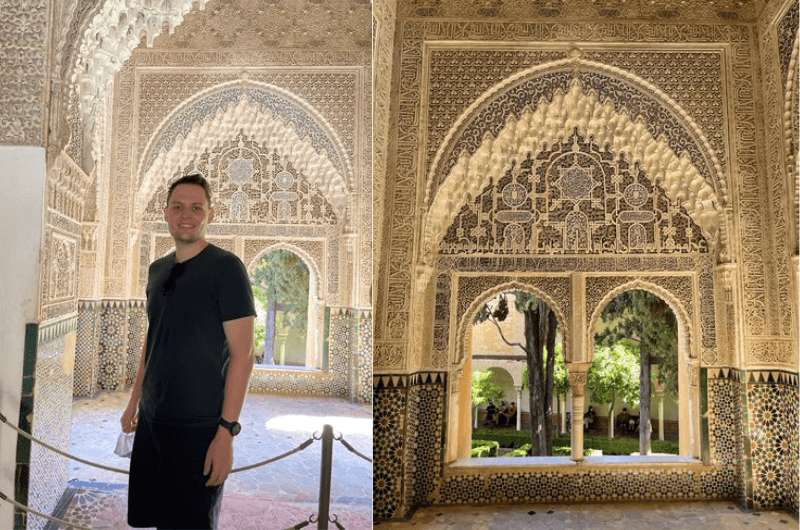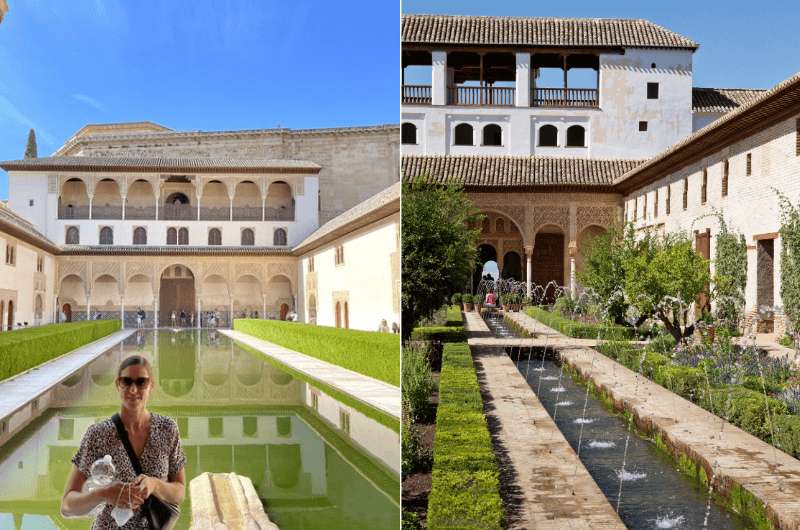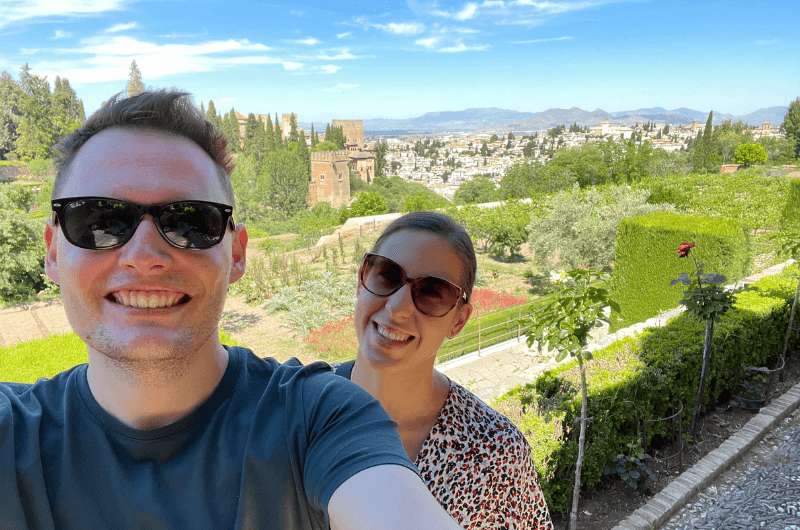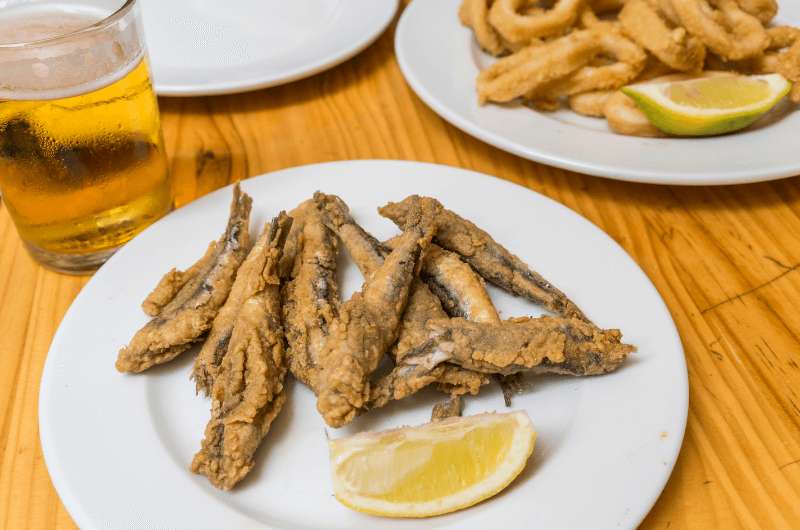7 Top Things to See and Do in Granada, Spain


Is it really worth going to Granada just for the one highlight, the palace complex Alhambra? Yeah, it is. Visit the city—whose name translates to “Pomegranate”—and prepare to feel like an Arab king for a day.
You might also be interested in reading:
- How to Visit the Alhambra in 2024: 32 Insider Tips and FAQs
- Andalusia Itinerary: Southern Spain in 10 Days
- Barcelona Itinerary: 5 days in Gaudí’s Metropole (with day trips)
- All You Need to Know about Spanish Tapas (+Restaurant Tips)
- The 10 Best Museums in Spain’s Top Cities
- The 16 Most Beautiful Beaches in Spain

The official flag of Granada. I feel like the pomegranate needs to be highlighted more…
Of course, there are other things to do while there, so don’t fret, we’re got you covered with a sprinkling of other things to see and do in Granada. You can use them as condiments for your Alhambra entrée. They are free, just like the tapas here.
If for some reason you don’t want to see the Alhambra, then no, don’t come to Granada. Add Gibraltar to your itinerary instead (I loved it there so much I can’t stop recommending it).

My design for the flag of Granada. You’re welcome.
You’d think that for one of the most visited cities in all of Spain, they’d set up some extra tourist attractions by now, like a strange museum or something. But no, it’s all still very traditional and old. Beware that these parts of Spain get extra toasty in the summer, with temps up around 38 °C (99 °F). Bring a fan and huge hat or something.
The tips in this guide will make for a pleasant 1.5-day, 1-night stay in Granada. If you’re in a hurry, you can be in and out within the same day. Just make sure you have your Alhambra tickets booked in advance! Details below.
1. The Alhambra

Look at those details!
The reason you are going to Granada in the first place: the Alhambra. This is the most impressive Moorish palace complex in the world, though some areas were added, reconstructed, demolished and rebuilt even during the Catholic reign that followed. It was the last Muslim stronghold in Spain before the Catholics took over.
Tip: I have an entire guide for you on visiting the Alhambra with every tip I could muster up and every one of your questions answered! Hop on over there to get all of my 32 visit tips and FAQs about the Alhambra.
The complex was built on the site of a Roman fortification, with the Alcazaba (the fortress) being built first. After that, each new ruler added on a new area, obviously trying to outdo the guy before him. And succeeding. This place is fantastic!

There’s always time for a coffee break! Plus our legs were killing us after 3 hours of walking around the Alhambra.
Here are a few basic things to consider before your visit:
- Don’t expect a palace. Expect a whole city. Make sure you have 3–4 hours to see everything.
- The Alhambra is on top of a hill. Expect a lot of walking up and down the hill, probably in the heat.
- Get your tickets up to 3 months in advance from the official website. Plan your visit to all the other parts of the complex around the 1-hour time slot indicated on your ticket for the Nasrid Palaces. Kids need their own tickets even though they enter free! More details on tickets below.
Tip: The Áurea Catedral Hotel is a modern hotel located just a couple streets from Plaza Nueva, where you will start your walk up to the Alhambra.
The Alhambra is split into three main areas: the Alcazaba (fortress), the Nasrid Palaces, and the Generalife (gardens).
You’ll likely enter through the Justice Gate (Puerta de la Justicia), which is the official entrance to the Alhambra.

One spot, two pics. Who else is a huge fan of the one on the left?
The Alcazaba is at the bottom of the Alhambra right next to the Nasrid Palaces. I found the fortress the least interesting of the Alhambra bunch. If you start there and aren’t impressed, hold your horses and head to the other areas, because that’s where the tiled, intricate, fountain-y magic happens.
The Nasrid Palaces are three separate palaces and they are incredible. Even you seen-it-all folks will say “wow” out loud at least a couple times. Just over the top, intricate details, holy macaroni, it’s really cool! It’s where the kings resided and worked, and also where the kings, ehm, met with their wives and girlfriends. In other words, there’s also a harem.
The Generalife is known as the place to admire the Alhambra gardens, though there is actually a palace up there too. It was built up above the Alhambra as a summer house for the sultans. I guess not all the tiles in the world can keep you content, so they sometimes got tired of all the fancy palaces down by the Alcazaba. When they needed to chillax, they hiked up a few minutes to this country estate and played checkers by the fountains (they actually didn’t, I made that up).
The gardens of Generalife are insane, with fountains and pools and just overall awesomeness. I dare you to not take a thousand pictures.
Make sure to get a sunset view of the Alhambra on at least one night—book a hotel so you don’t have to hurry away too soon.

Look at the pools, the gardens, the Karin!
If you’re excited just thinking about the palaces in Andalusia, you’ll want to make time to visit Sevilla. It’s Alcazar is tiles gone wild and absolutely stunning! The Alhambra in Granada is world class though, so... I call it a tie! Not that it’s a competition or anything.
- Enter through the Justice Gate (Puerta de la Justicia)
- Open daily 8:30 am–8 pm (closes at 6 pm from October to March). Night visits available, too.
- General day ticket is EUR 19.09 and includes a time slot for the Nasrid Palaces. There are other options available, though in my opinion it makes no sense to leave any of the areas out to save a few euros. See my full Alhambra guide for all ticket options.
2. Albaicín

Pretty charming, right? Walking through Albaicín
Unless you want to play detective and find a hidden viewpoint that nobody knows about (good luck with that!), the best views you’ll get of the Alhambra can be found at Plaza de San Nicolás in the Albaicín neighborhood.
Come here at sunset. Even though there will many other people here for the exact same reason, catching the Alhambra bathed in the last orange rays of the sun is an experience. Of course since tourists gather here, there are a ton of bars that won’t let you stay thirsty or hungry for long. The area is bustling and the atmosphere is full of energy. Get your Alhambra pics and soak it all in.
Albaicín is where the Moorish population moved to after the reconquest of Granada by the Catholics, and you can see the influences of Muslim architecture everywhere.

There she is, isn’t she a beauty? The Alhambra at sunset
Besides the Alhambra, you’ll also see the peaks of the Sierra Nevada in the background, and the entire city of Granada with its surrounding hills right below you.
Tip: For stunning views right from your hotel window, try the charming Hotel Casa Morisca in the Albaicin neighborhood. There are also many apartments available, like Carmen de Vidal, which gets you a full view of the Alhambra as well.
3. Sacromonte

Look at these two happy tourists enjoying the views!
While visiting the Alhambra is a no-brainer, you won’t be able to get a good look at it in its entirety while standing in the middle of it.
For the best views, you’ll need to head up to the neighborhoods on the surrounding hills. One of these is Sacromonte, the Gypsy quarter of Granada. The higher up you go, the better the views get.
This neighborhood is special in that the dwellings are carved right into the mountain, making caves for homes. Nowadays, they’ve become more elaborate and aren’t as humble as back in the day, and some are now restaurants or flamenco cuevas. But it’s still a very traditional neighborhood that is fascinating to see.
The streets here are narrow and can be confusing, but that is part of the charm. The houses are whitewashed, with flowers in blue flower pots and ceramics adorning the walls.
You can start your walk up from the river at Cuesta Del Chapiz and then stray into the smaller alleys.

Looking up to Sacromonte neighborhoods
For a little more history, head up to the museum, where you can visit almost a dozen cave houses that have been recreated to look like they did back in the day. If you’re curious to see how people actually lived, this is a fun stop. The €5 is worth the 20-minute walk through (or more if you’re really into it). Located at Barranco de los Negros.
4. Free tapas

If you don’t want veal brain, these guys probably still have their brains, too
Have you heard of the free tapas in Granada? Yeah, it’s a thing here. For each drink you order you get a small, yummy something. The more drinks you order, the better free tapas you will get.
Unless you want to dive really deep into local culture, beware of the typical Sacromonte tortillas: one of the key ingredients is veal brain. Bon Appetite!
Unlike the tourist trap restaurants on Calle Navas, the tapas can be absolutely awesome. Instead, head into the streets around Plaza Nueva. We were lucky there with amazing finds, like Bar los diamantes, Bar La Trastienda or Bar Casa Julio 1947.
In some places, like La Riviera, you can even choose your free tapas from the menu. Now that’s luxury!
In Taberna La Tana, further south, we got the most amazing cured ham, it didn’t even feel right not paying for it! It’s not every day you eat for free. Granted, the drinks aren’t cheap. Still, at one point I felt like they can tell I’m ordering another beer but really just want more tapas.
If you spend more than a day in Granada and start getting a feel for the place, head over to Cisco y Tierra and you’ll feel like a local and long-time friend of the owner. He’ll be the one talking to all the guests, offering the homemade vermouth.
Don’t forget to read up on tapas culture before you go!
5. Alcaicería market

You’ll need to look for treasures to buy amongst the stalls selling the same thing
This being the last place where the Moors held strong before the Catholics ran them out of the country, you can bet your boots there is a bazaar to spend your money in.
Walk the narrow streets of Alcaicería market, the former Moorish silk market, where you can get everything from clothes to tea and spices. The market is only one main street now, much smaller than it used to be. And on first glance, you might feel the need to run away due to the numerous kitschy souvenirs that you will be bombarded with. But persevere and you will be successful!
Try finding traditional painted ceramics or fantastic deals on leather bags. They are great quality and will last forever. Unless you drop the ceramics or lose the bag, but that’s on you. We brought home some pretty snazzy leather slippers!
It’s not incredible, but in a town with not much else to do but visit the Alhambra, you can kill half an hour looking for a treasure. The sellers aren’t pushy, so you can browse without being cornered every time you stop to look at something.
6. Bullfighting arena

The only bulls you should be seeing in Granada
I am not a fan of watching bulls get poked to death, but accept that it’s part of the Spanish culture. You can’t form an opinion without getting educated, so we stopped by the bullfighting arena for a tour.
Compared to the tour in Ronda this one was more interactive, and it gave us as idea as to why bullfighting is still a thing. The tour guide’s enthusiasm was infectious, and she explained the history and facts of the “sport” really well. Plus, you can dress like a matador and pretend it’s all fun and games!
The tour costs €8 and lasts about an hour.
Tip: Stay at Palacete 1620, Premium Suites, a renovated 400-year-old house turned into amazingly comfortable apartments with staff that treat you like royalty.
7. Flamenco

Flamenco is basically a live telenovela
Flamenco might be one of the first images in your mind when you think of Spain, along with tapas, bullfighting and the extroverted, sociable people (I didn’t want to just call them loud).
The dance is more of a performance, full of drama and emotion, with lots of hand clapping, foot stomping, and skirt swooshing. And the performers never smile. Drama, people, drama!
For an authentic flamenco experience, get out of the city center and walk around the streets of Sacromonte and look out for flyers posted on the doors of the cuevas, the caves carved into the mountain. These small rooms have been lined with chairs for spectators and it can get cramped, so you get a really close up look (and sometimes feel, like when a dancer’s skirt smacks you right in the face).

The entrance to one of the bigger flamenco cuevas in Sacromonte
Be warned that this can be a really intense experience and if it’s not your jam, you’ll just end up feeling awkward and wishing for the end. But what the heck, you’re probably only in Granada once, give it a go! If all else fails, you can pass the time by trying to spot anyone smiling.

A map showing the location of everything mentioned in this post
This post may contain affiliate links. We earn a small commission if you make bookings through my links, at no additional cost to you. This helps us keep this blog free, thank you!










Comments | Thoughts? Give us a shout!